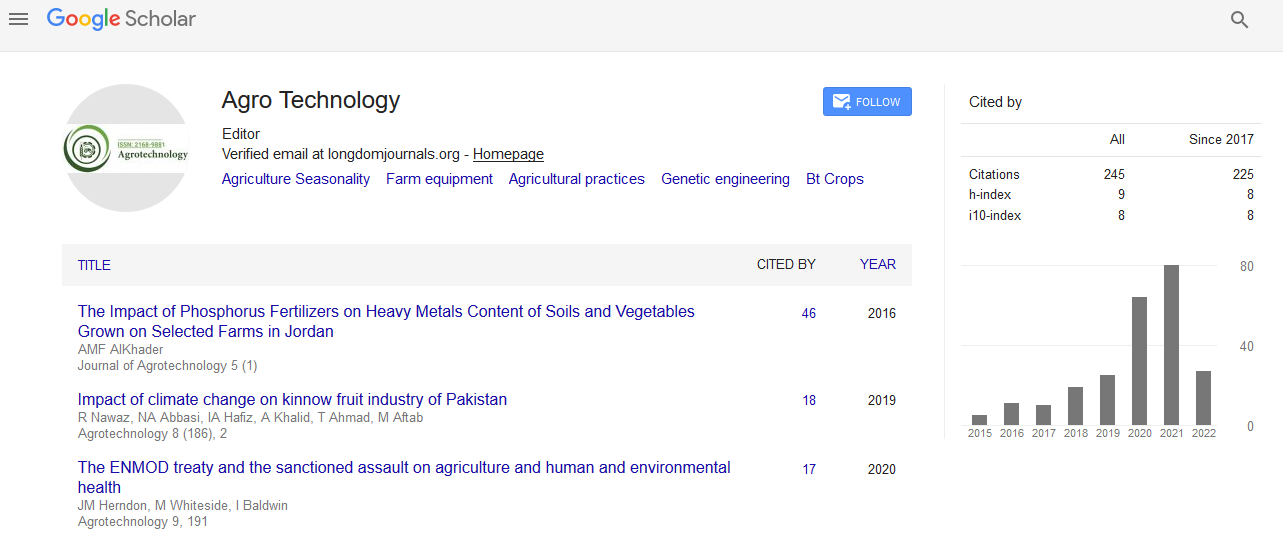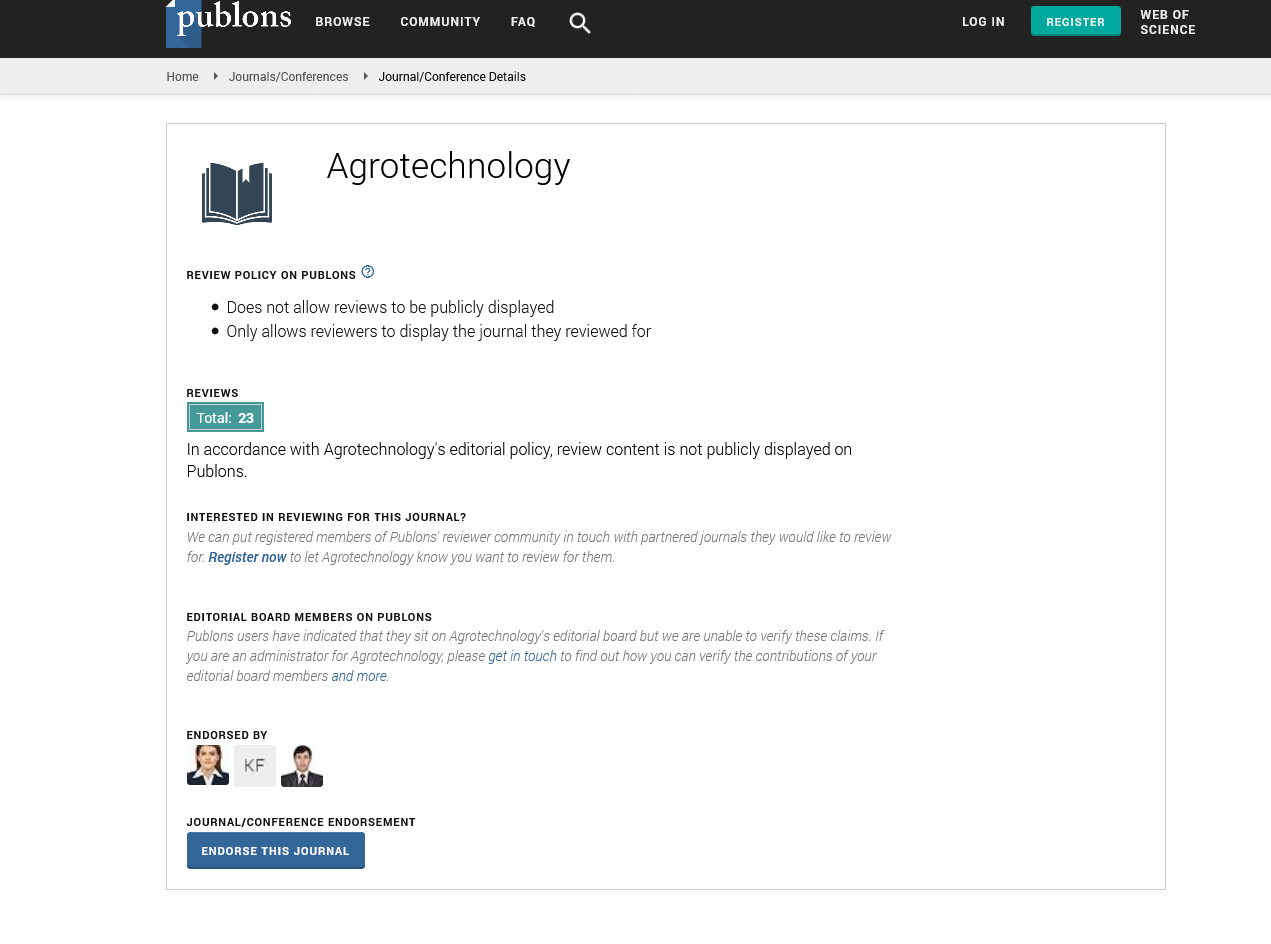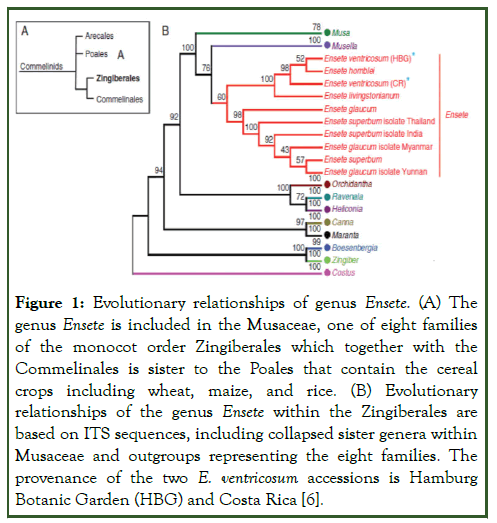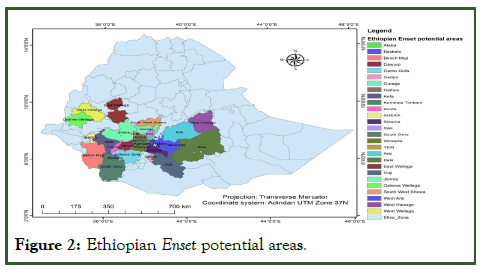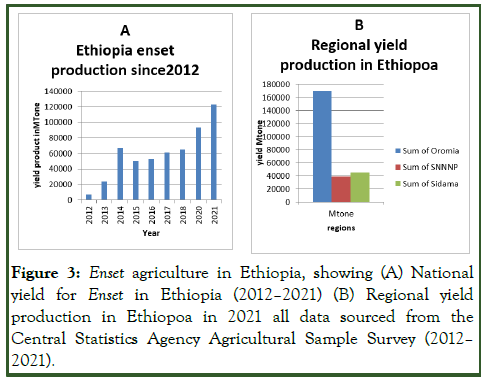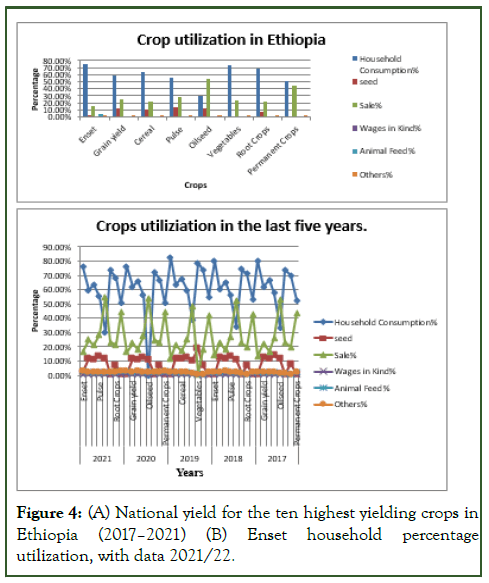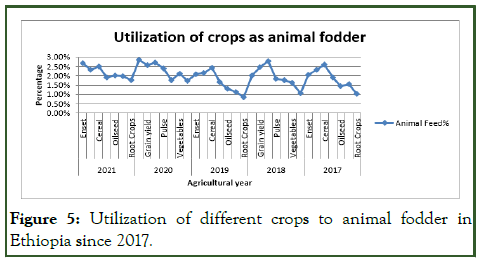Indexed In
- Open J Gate
- Genamics JournalSeek
- Academic Keys
- ResearchBible
- Cosmos IF
- Access to Global Online Research in Agriculture (AGORA)
- Electronic Journals Library
- RefSeek
- Directory of Research Journal Indexing (DRJI)
- Hamdard University
- EBSCO A-Z
- OCLC- WorldCat
- Scholarsteer
- SWB online catalog
- Virtual Library of Biology (vifabio)
- Publons
- Geneva Foundation for Medical Education and Research
- Euro Pub
- Google Scholar
Useful Links
Share This Page
Journal Flyer
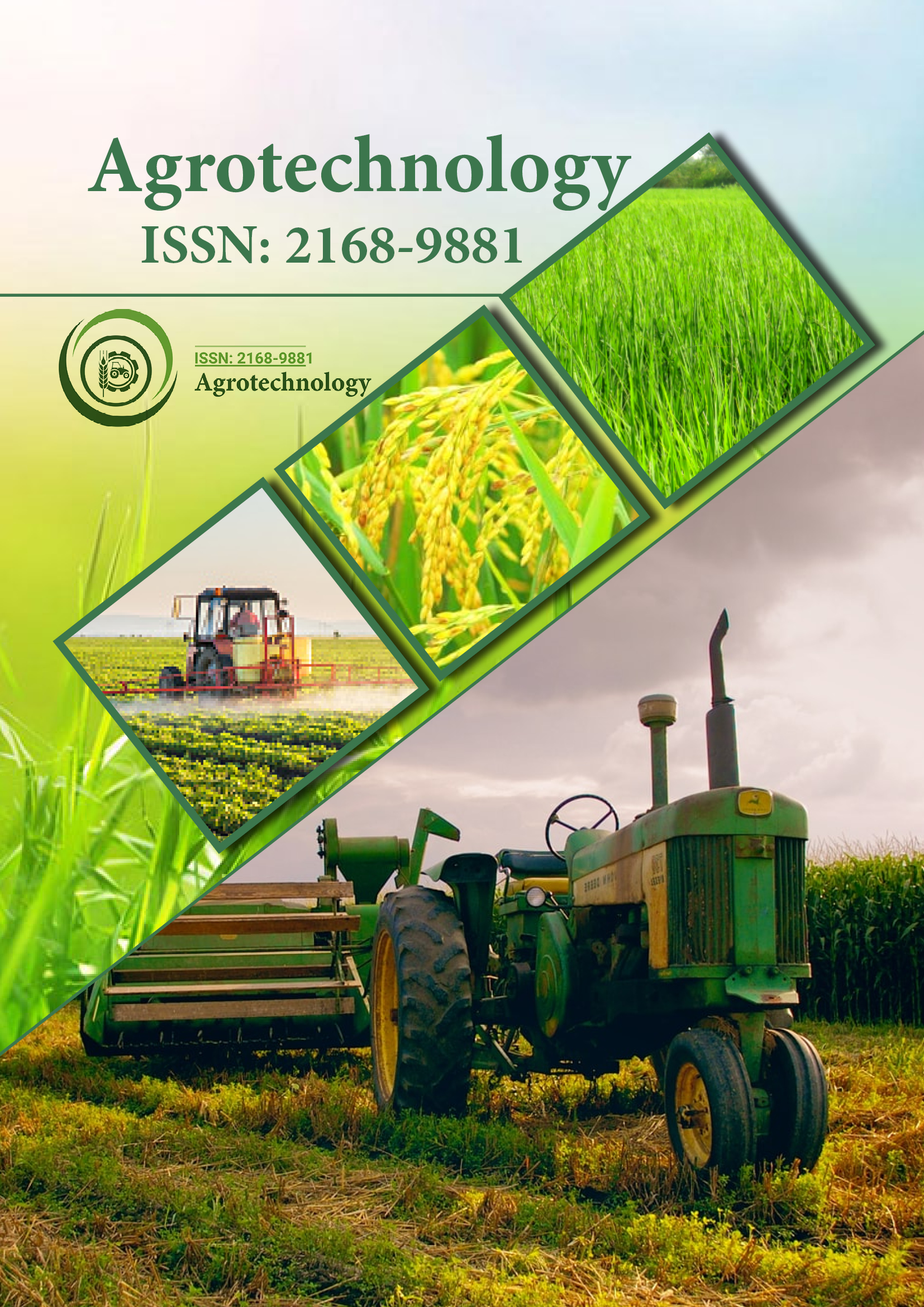
Open Access Journals
- Agri and Aquaculture
- Biochemistry
- Bioinformatics & Systems Biology
- Business & Management
- Chemistry
- Clinical Sciences
- Engineering
- Food & Nutrition
- General Science
- Genetics & Molecular Biology
- Immunology & Microbiology
- Medical Sciences
- Neuroscience & Psychology
- Nursing & Health Care
- Pharmaceutical Sciences
Review Article - (2024) Volume 13, Issue 5
Enset (Ensete ventricosum (Welw.)) Crop Production, Genetic Variability, Utilization, Trends, Challenges, and Future Prospects in Ethiopia
Asmare Zerfu*Received: 11-Oct-2023, Manuscript No. AGT-23-23535; Editor assigned: 15-Oct-2023, Pre QC No. AGT-23-23535 (PQ); Reviewed: 29-Oct-2023, QC No. AGT-23-23535; Revised: 05-Sep-2024, Manuscript No. AGT-23-23535 (R); Published: 12-Sep-2024, DOI: 10.35248/2168-9881.24.13.395
Abstract
Enset (Ensete ventricosum (Welw.)) Chessman is a perennial, large herbaceous plant that belongs to the Musaceae family monocarpic crop. It is an African crop that at this time provides the staple food for millions of Ethiopians. It is perhaps the only widely grown and domesticated crop in Ethiopian that has never been cultivated outside Ethiopia, despite wild populations of E. ventricosum occurring from Ethiopia, and the eastern Democratic Republic of Congo (along the rift valley mountain ranges) to South Africa. This extremely localized cultivation (though by many sociocultural and ethnolinguistic groups) may in part explain limited research to date, despite indications that enset could play a major role in maintaining food security contests, not only in Ethiopia but also further abroad.
Keywords
Ensete ventricosum; Cultivation; Food security
Introduction
Enset is an extraordinary plant/crop from a sister genus to the bananas (Musa). Like banana, enset has a pseudostem of overlapping leaf sheaths, and large paddle-shaped (oblonglanceolate) leaves and produces a massive pendulous inflorescence with banana-like fruits. However, unlike bananas, enset does not produce edible fruit (these are filled with numerous large and hard seeds, similar to many other wild banana species). Instead, the plant is grown for 4-7 years, before the pseudostem and corm are harvested and collectively processed into starchy food products. On contrary, reported that the plant matures after 9-14 years; the true stem emerges through the leaf sheaths and produces inflorescences. The best time for harvesting is just after the production of 8 inflorescences and seed sets. However, enset can be harvested at any time during the year, be harvested at any growth stage over a period of man-years (up to and including the early flowering stage), and the fermented products can be stored for long periods [1].
It serves as a staple and co-staple food for over 20 million people in some parts of Oromia, South Nation and Nationality people, and Sidam regions mainly in the south and south-west of Ethiopia. As reported by Demeke, under appropriate conditions it is estimated that 60 mature plants can produce enough food for a family of five to six persons over the course of a year, when consumed with other food like meat, dairy, fruit, and other vegetables.
Enset agriculture systems chip into the lengthy sustainability of food production through distinct mechanisms. Enset is perceived to be relatively tolerant of drought with stand heavy rain, tolerate flooding, and endure frost damage. It can be reaped at any growth stage over a period of many years and the fermented products can be stored for long periods. This conflation of characteristics gives enset an important role during times of famine in the areas in which it is traditionally cultivated. Enset's resilience and versatility have earned it the name 'The Tree against Hunger' and it forms the basis of many households' food security [2].
I reckon that there are challenges to the improvement of existing enset farming practices and the adoption of enset-based agriculture outside of the current distribution in southwest Ethiopia. The first is a poor characterization of ecological requirements, morphological cytological and molecular-based genetic diversity, and the impact of changing climate, recently reviewed in a companion paper by Borrell et al. The second, addressed here, is poor documentation of the extensive ethnobotanical knowledge and practices associated with enset cultivation, and recent enset household production trends in a national framework. The key purpose of this paper is:
• To evaluate the annual production of enset in Ethiopia.
• To review the genetic resource of enset crop in Ethiopia.
• To sum up the existing knowledge and current research effort
in Ethiopia
• To review the importance of enset crop in Ethiopia.
• To find critical knowledge gaps in the diversity and
distribution of enset to direct future research efforts.
• To assess production trends, challenges, potentials, and future
opportunities of the crop.
Literature Review
Origin and taxonomy
Enset (Ensete ventricosum) is the perennial monocarpic crop, belonging to Kingdom. Plantae Order Advances in Life Science and Technology www.iiste.org ISSN 2224-7181 (Paper) ISSN 2225-062X (Online) Vol.61, 2017 8 Zingiberales and family Musaceae along with bananas. Musaceae is a family of (monocotyledonous) flowering plants. The family is native to the tropics of Africa and Asia consisting of 2 genera, Musa and Ensete, with about 50 species. They are grown mainly for their fruit, the banana, and for their fibers, manila and hemp, used for making rope. They are also grown as ornamental plants. Enset (Ensete ventricosum) is Ethiopia's most important root crop, a traditional staple in the densely populated south and southwestern parts of Ethiopia [3].
Pankhurst reported that enset cultivation in Ethiopia may have started around the 15th century, south of the Ghibe River. On the contrary, enset was first observed by the Scottish traveler James Bruce during his travel to discover the source of the Nile in 1768-1773. Bruce reported that enset grows to great perfection in Gonder, west of the Nile, and near Lake Tana, where there are large plantations to produce the food of the people inhabiting that province. Simmonds reported that enset was once an important food and fiber plant in Upper Egypt, perhaps more widespread during the Neolithic wet period than it is now. However, historical evidence regarding the origin and domestication of crops is seldom completely trustworthy [4].
For many years both enset and banana were considered species and under the genus Musa. Although its first discoverer, James Bruce, emphatically stressed ensete’s difference from the Musa, Horaninow in 1862 became the first to propose a distinct new genus for it under the name of ensete. The species name Musa ventricosum was first detected by the Australian Botanist F. Welwitsch in Angola in 1857. Cheesman made genetic and taxonomic investigations and related 25 African and a few Asian Musa species to the genus ensete.
Enset (Ensete ventricosum (Welw) Cheesman) is a perennial monocarpic crop belonging to family Musaceae and genus Ensete. However, enset was considered a member of the genus Musa as it strongly resembles banana morphologically and because of this some of the species’ names formally given to enset were Musa ensete and Musa ventricusa. Then Chessman characterized the basic difference between musa and enset. The genus ensete comprises seven species (E. ventricosum, E. homblei, E. livingstonianum, E. superbum, E. perrieri, E. lecongkietii and E. glaucum). Ensete lecongkietii wild relative species alternatively named orphan banana grows solely in Vietnam which is not evaluated its conservation and distribution status because of the most recently described Ensete species. Ensete superbum and E. glaucum grow in Asia, whereas E. ventricosum, E. gilletti, and E. homblei occur in sub-Saharan Africa and E. perrieri in Madagascar. Ensete ventricosum grows wild also in a number of countries in central and eastern Africa including Congo, Mozambique, Uganda, Tanzania, and Zambia. Enset has only been domesticated in Ethiopia [5].
Currently, Ensete (seven species) and the sister genera Musa (approx. 70 species) and Musella (one species) belong to the Musaceae within the order Zingiberales, together with eight tropical plant families (Figure 1).
Figure 1: Evolutionary relationships of genus Ensete. (A) The genus Ensete is included in the Musaceae, one of eight families of the monocot order Zingiberales which together with the Commelinales is sister to the Poales that contain the cereal crops including wheat, maize, and rice. (B) Evolutionary relationships of the genus Ensete within the Zingiberales are based on ITS sequences, including collapsed sister genera within Musaceae and outgroups representing the eight families. The provenance of the two E. ventricosum accessions is Hamburg Botanic Garden (HBG) and Costa Rica [6].
Distribution and ecology of enset
In Ethiopia, wild Enset ventricosum occurs in the highlands of the Southwestern part. Many researchers reported that wild enset is widely distributed in SNNP Bonga, Kaffa, Omo River (Gamo Gofa zone), Sheka Forest. Herbarium records indicate the historical presence in Metekel (Benishangul-Gumuz region), West Wellega (Oromia region), Kefa, and Sidama zones (SNNPR region). In addition to this, the domesticated enset is highly distributed throughout SNNP and newly established Sidama regions as well as the southwest region of Oromia while the highest enset growing region is Oromia. Its habitat is ranging from dense forests, and agroforestry/intentionally integrated with trees and shrubs into crop and animal farming systems/ to open shrub land, or along riverbanks [7].
Enset can be reproduced both sexually and asexually. The most common and traditional method of enset propagation is vegetatively by using suckers. An enset plant has three main parts, an underground corm, an aerial pseudostem made of overlapping leaf sheaths, and several broad leaves. Enset is a large plant with a height of 12 m and a pseudostem that is dilated at the base and that has a width of up to 1 m. The growing point of the plant or meristem is located at the junction between the pseudostem and the underground corm near the soil surface. There are usually about 10/200 plants in a population.
Although areas, where wild enset grows, are often not suitable for human settlements, human interference still prevails through the raising of domestic animals and cutting of trees and shrubs. It is cultivated and grown in a wider area comprising the central, South, and Southwestern parts of Ethiopia, but mainly at higher altitudes ranging from 1500 to 3100 m but smattered plants can also be found at lower altitudes. However, Tsegaye, finding report indicated that for optimum growth, the plant requires an average rainfall of 1100-1500 mm per year, mean temperature of 16-20°C, and humidity of 63-80 percent. In addition to this enset grows well in most soil types, provided they are adequate fertile and well-drained with moderately acidic to alkaline (pH 5.6 to 7.3) soil with 2-3% organic matter. The above abiotic factors can be a possible cause of variation within the species of Southern and South-Western parts of the country [8].
Annual production of enset in Ethiopia
Enset represents 65% of the total crop production in the southern regions of Ethiopia. The number of enset trees to be harvested, in the current agricultural year (2020-21), from all over the country is estimated to be 206,659,076. In the 2021 agricultural year, it harvested over 122,485.695 tonnes in Ethiopia. It has the main fermented food products which is used in human beings’ daily diets are kocho, bulla, and Amicho in southern and south-western parts of Ethiopia. Kocho is the most common bread-like staple food product made from enset and is prepared from the pulp of fermented pseudostem and corm. Bulla is the starchy water-insoluble product separated from kocho during processing from the pseudostem and is used as porridge or as a flatbread. Unlike kocho, Amicho can be sometimes eaten unfermented boiled form of enset clones of corm chunks. Therefore, its production can be harvested in different forms these are; the form of Amicho (57,189,207.53), Kocho (63,445,734.58), and Bula is 1,850,753.10 quintals. Moreover, the productions of Amicho, Kocho, and Bula in quintal per tree are 0.28, 0.31, and 0.01 quintals respectively. Most of the farmers reported that the amount of kocho obtained from one enset plant ranges from 15 to 61 kg. Enset productivity is very high compared to other crops but varies depending on edaphic factors, altitude, cultural management, type of clone, and growth stage. Statistical data of enset productions in Ethiopia shows enhancement from year to year however it is too low compared to agricultural research center standard yield production. The agricultural practicing system such as plant spacing, fertilizer application, harvesting system, and selection of productive landraces are poor. Those all hindrances are limited annual production of enset crop in south-west regions of Ethiopia [9].
Enset is grown in the South-western part of the country and covers the considerable land area within the private holdings mainly in the three regional states namely South Nation and Nationality, Oromia, and the newly established Sidama region. As CSA (2020/21) reported Oromia is the highest enset producer region in Ethiopia’s seed (Figure 2) [10].
Figure 2: Ethiopian Enset potential areas.
Importance of enset crops
The food crops on which data is collected are the ones that are commonly grown by the majority of peasant holders. In the statistical tables, these crops have been categorized into nine groups for simplicity of description and comparison purposes. The groups are cereals, pulses, oilseeds, vegetables, root crops, fruit crops, stimulant crops, sugar cane and enset. Enset is a versatile crop that all botanical part is used for numerous cultural applications, not only for food but also for medicinal value and livestock feed. It is considerably contributing to food security issues and accounts for 75 percent of household consumption, 16 percent for sales and 7 percent accounts for wages in kind and others (Figure 3) [11].
Figure 3: Enset agriculture in Ethiopia, showing (A) National yield for Enset in Ethiopia (2012–2021) (B) Regional yield production in Ethiopoa in 2021 all data sourced from the Central Statistics Agency Agricultural Sample Survey (2012– 2021).
Permanent crops are also used as cash crops like oilseeds. In general, it is rational to conclude by looking at Figure 1 that the peasant farmers consume most of what they produce leaving little to sell. Several findings show immense multipurpose of enset which provides fibres, medicines, animal fodder, and packaging material stabilizes soils and microclimates and is culturally significant. To sum up, utilization of enset in 2021 is indicated in Figure 1 and the last five years are also summarized in Figure 2. Owing to its morphology, growth habit, and cultivation practices, enset can be grown with minimum tillage helping reduce soil erosion, land degradation and loss of productivity. In addition to this, it is important as animal fodder and has medicinal value (Figure 4) [12].
Figure 4: (A) National yield for the ten highest yielding crops in Ethiopia (2017–2021) (B) Enset household percentage utilization, with data 2021/22.
Nutritional value and its composition
A previous study confirmed that enset plantation in Ethiopia is a major diet for more than 20 million people. The nutritional value of enset analysis showed marked significant variability in the nutritional composition of the corms, leaves psedostem, and other parts of enset; this made the selection of nutritionally-rich Enset landraces and environmental factors possible. Many researchers are reported different enset nutritional compositions. Enset crop provide important dietary micronutrients such as protein content (0.90 to 2.39%), crude fibre (0.83 to 1.1%), carbohydrates (27.3 to 39.4), Fe (1.1 to 4.3 mg/100 gm), Zn (6.2 to 15.6 mg/100 gm) and Beta carotene (1 . 5 to 22.2 μg/100 gm) were recorded.
Daba and Shingita found that enset is rich in starch but poor in protein content. They did the nutritional value of bulla protein content 0.65 g/100 g, moisture 7.5 g/100 g, fat 0.11 g/100 g, carbohydrate 97.18 g/100 g, fiber 1.08 g/100 g, energy 393.17 kcal/100 g. In addition to this, the composition of minerals in Mg/100 g were sodium 4.01, phosphorus 32.65, iron 7.58, calcium 63.67, potassium 387.20, magnesium 12.91, manganese 0.73. Bulla contained fewer minerals than kocho. However, both bulla and kocho are rich in calcium and zinc compared to other locally available starchy crops and contains a comparable concentration of copper, iron and manganese. Tamrat et al., reported that the enset tissues (pseudostem and corm) and processed food products (kocho and bulla) contains all 20 amino acids and has similar or higher concentrations than potato for 12 of them. In a dietary survey of 39 households containing 237 people, Pijls et al. showed that the average daily intake of 0.55 kg of enset products provided 68% of the total energy intake, 20% of the protein and 28% of the iron, but no detectable level of Vitamin. Tsegaye note that farmers partly identify different enset landraces based on the qualities of the kocho, bulla, and amicho they produce. In Southern Ethiopia, sidama zone found that cereals (mainly unrefined maize) provided the major source of energy, protein, iron and zinc, whereas starchy foods prepared from enset were the primary source of calcium and an additional source of iron [13].
Medicinal value
Enset plant and its parts contribute to indigenous ethnomedicinal values of the south-west Ethiopian people across diverse ethnic groups. Traditional healers in the area confidentially keep ethnomedicinal knowledge of enset clones and many other medicinal plant and animal species. They characterize phenotypic traits of medicinally important enset landraces. Primarily, but not always, plants used medicinally have red or reddish-purple leaf blades with midribs and pseudostems that are red to a varying degree. There are two principal medicinal properties commonly attributed to enset. First, boiled corm (amicho) of various varieties, often consumed with milk, allegedly cures fractured or broken bones.
Mostly administered in the form of food products, traditional enset medicines include attributed to the high calcium content of certain landraces for strengthening women after delivery and healing bone fractures in humans. Second, the amicho of several varieties is consumed with milk and butter to facilitate placental discharge in both humans and livestock. Highly fermented landraces are important for curing stomach cramps, boiled corm for birth control and abortion in humans, and feeding cows to facilitate placental expulsion. In addition, Pijls et al. Holscher and Schneider reported the use of enset root to treat nematode worms. Phenylphenalenones may have anti-bacterial, anti-cancer, and nematicidic properties Holscher and Schneider. Tsegaye found that farmers in Sidama, Wolaita, and Hadiya used the corm or other parts of specific enset landraces to cure cirrhosis, diarrhoea, or venereal diseases.
Animal fodder
Several studies have identified the leaf as a good source of animal fodder, containing 13% protein, 20% crude fiber and 10% sugar. It is also a good starting material for silage production. There is not enough fiber in the pseudostem to make it a suitable fodder for ruminants, but this problem can be avoided if the remains of the pseudostem, after kocho preparation, are mixed with other plants material. The pseudostem, like the leaf blades, contains potassium, magnesium, zinc and manganese in suitable amounts for ruminants, while the calcium levels are not high enough to support the animal and lactation. The pseudostem provides a similar amount of energy to oats and performs similarly to barley in net energy provision for lactation. Therefore, enset is most important crop to provide animal fodder in comparable approach Figure 5 [14].
Figure 5: Utilization of different crops to animal fodder in Ethiopia since 2017.
Enset genetic variability
Genetic diversity refers to variation in genes and genotypes between and within species. It is the sum of the variation contained in the genes of individual plants, animals and microorganisms. In crop plants, genetic diversity comes as a result of differences in genetic composition or the environment in which they were raised. The basic idea of the study of variation is the partition of variability into its component that determine the genetic properties of the population which help in formulating a sound crop breeding program. Diversity within the species permits an organism to adapt to environmental changes and climate or to the presence of biotic and abiotic stresses. Productivity as a complex character needs a detailed analysis of its component in the improvement program [15].
In Musa there are over 1000 landraces with high genetic diversity, indicating multiple origins from different wild M. acuminata and its hybrids with M. balbisiana. The movement and interactions of various human groups have played an important role in generating this diversity. Most landraces arise via selection (by farmers) of spontaneously occurring mutants with parthenocarpic fruit production. These are brought under cultivation, multiplied and distributed by vegetative propagation. Extensive hybridization has occurred, including between diploid wild species or genotypes, involving unreduced gametes, and perhaps residual fertility of triploids. Due to the high levels of domestic diversity indicated in genetic studies and the overlapping spatial distribution of wild and domesticated enset, it seems likely that there were also multiple domestication events in enset, and/or frequent local introgression from wild populations. However, unlike Musa, we hypothesize that all domesticated enset landraces arose from a single species, E. ventricosum, as this is the only member of the genus present in Ethiopia or the surrounding region. More detailed diversity studies of wild and domestic enset in Ethiopia are required to elucidate the number of domestication events and population structure.
A further distinction is that enset is currently only reported to be a diploid chromosome with n=9, whereas Musa species, including edible bananas, have different ploidy levels and chromosome numbers (diploid, triploid or tetraploid), with n=7, n=9, n=10, and n=11 at various ploidy levels; domesticated varieties are commonly sterile. Species in the genus Ensete have relatively small DNA content, reported to be about 620 Mb per haploid genome for E. livingstonianum (measured by flow cytometry) and 547 Mb for E. ventricosum (estimated from wholegenome sequencing). This is similar to the genome size of haploid Musa species, ranging from 580 to 800 Mb measured by flow cytometry and the lower estimates from whole-genome sequencing of 523 Mb for M. acuminata. Ensete species have n=9 chromosomes and the karyotype consists of mainly biarmed chromosomes of similar size, each slightly bigger than those in bananas [16].
Phenotypic and genotypic diversity of enset in Ethiopia
Biological diversity is the presence of variation among and within the living world. No two living things (even maternal twins) are unerringly similar to each other. Variability is the difference in one or a few traits of the organism due to the variation in alleles of genes or variation in DNA/RNA sequences in the gene pool. Knowing Genetic diversity and their relationships has tremendous significance for crop improvement strategies to release superior cultivars in crop improvement. The genetic diversity of plants can be estimated using three ways of genetic markers that are morphological, protein (biochemical), and DNA (molecular) markers. However, the majority of studies trust indigenous knowledge for the identification of more than 300 differing enset landraces and some authors have also attempted to document and analyze enset landraces using selected phenotypic characters. Genotypes in comparison with other important food crops, there are few studies employing molecular markers for germplasm characterization and evaluation of genetic diversity in enset. Initially, Zippel and Kefale developed a field survey technique for the rapid identification of enset clones based on morphological characters, principally color.
In later researchs, Tabogie reported significant variation among 79 enset accessions collected from different parts of Ethiopia and attempted to associate yield with different traits. Various indigenous cultivated enset were identified in Sidama (52), Wolaita (55), and Hadiya (59) using the initiation of suckers, frequency of transplanting, leaf pruning, and planting patterns morphological traits simultaneously the author reported 58% polymorphic among clones using AFLP marker. Bekele et al. undertook a similar study and categorized 120 distinct enset landraces into 11 clusters using morphological descriptors. This suggests that there is indeed high diversity in desirable crop traits. Other authors report similar morphological diversity in field surveys [17].
Discussion
Birmeta et al., reported a high level of genetic variability among the tested germplasm as well as considerable duplication of vernacular names among 111 cultivated enset clones collected from nine enset-growing regions in Ethiopia. Similarly, Negash et al., disseminated the presence of genetic diversity and relatedness among 146 cultivated enset clones collected from four regions, in Ethiopia. Two ISSR markers produced 26 clear scoreable bands and clustered all the 71 cultivated enset landraces into two major groups, which aligned with their collection regions. Olango et al. developed the first set of genomic microsatellite markers from pyrosequencing of an enriched genomic library of E. ventricosum and examined their cross-genus transferability to related taxa, using them to estimate genetic diversity, as well as relationships between wild and domesticated enset accessions. The analysis demonstrated that intra-population allelic variation contributed more to genetic diversity than inter-population variations. Phylogenetic data combined with principal components analysis results revealed that wild enset clustered together and were distinct from domesticated enset landraces sampled across the region. To sum up previous studies revealed the presence of high genetic potential which used to give a great opportunity for plant breeders to enhance productivity to maintain food security for an ever-increasing population (Table 1) [18].
| Marker | Aims | No. of markers | No. of genotypes |
|---|---|---|---|
| Agro-morphology | Estimate the genetic diversity of enset in the Ethiopian. | 7 agro-morphological traits | 286 |
| Isozymes | There is no data | ||
| RFLP | There is no data | ||
| RAPD | Studies the genetic distance between cultivated and wild enset. | 72 loci | 14 |
| AFLP | Estimate the genetic diversity of domesticated and wild enset crops among and between populations. | 111 Loci | 230 |
| ISSR | Investigate the genetic variation among populations of cultivated enset. | Two ISSR primers | 71 |
| SSR | Genetic diversity and the relationship that exists within and among enset landraces used in traditional medicine and those having other use-values | 15 loci | 51 |
| SNP | Genetic relatedness and population structure of cultivated and wild enset accessions | 5169 SNP markers | 141 |
Table 1: Previous genetic and genomic studies of wild and domestic E. ventricosum in Ethiopia.
Major challenges of enset production in Ethiopia
I emphasize that there are a few major limitations for the advancement of existing enset cultivating hones and the selection of enset-based farming exterior of the current dissemination in enset developing locale of Ethiopia. The primary barely characterization of biological necessities, hereditary differences, and the effect of climate alter, as of late reconceived in a companion paper by Borrell et al. Secondly, enset is seriously affected by plant-parasitic nematodes, with recent studies indicating record levels of infection by the root lesion nematode Pratylenchus goodeyi in addition to this enset is also heavily affected by Bacterial wilt which is caused by Xanthomonas vasicola pv. musacearum (Xvm). The moment tended to here, is destitute documentation of the broad ethnobotanical information and hones related with enset development and later enset family generation patterns in a national setting. Smallholders account for 96% of the developed range in Ethiopia compositions with at slightest 48 ethnic bunches local to the Southern Countries, Nationalities and People groups Locale (the major enset developing locale), 88 recorded dialects belonging to four major groups (Omotic, Semitic Nilotic, and Cushtic) and a corresponding multitude of ethnobotanical practices. Therefore, here I investigated and summarized reported uses and management of enset, recent trends in cultivation, emerging by-products, and opportunities for improvement. I expect that by providing a framework indoors which to report enset ethno-botanic research, I can enable and catalyze the development of this important Ethiopian food security crop.
Even though enset production plays major economic and social roles, it is not included widely in the extension package. Little attention was given to research and extension services. Moreover, substantial research and development have not been carried out in the enset growing areas of the country for processing of enset in order to facilitate wide consumption (Figure 6) [19].
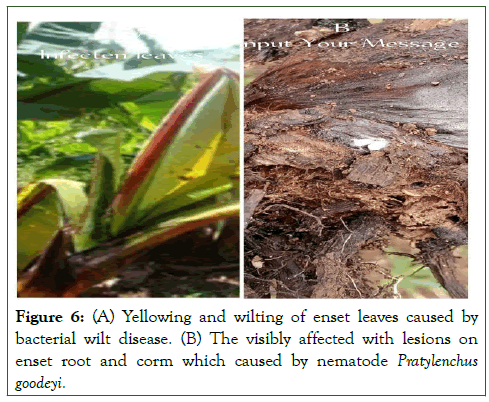
Figure 6: (A) Yellowing and wilting of enset leaves caused by bacterial wilt disease. (B) The visibly affected with lesions on enset root and corm which caused by nematode Pratylenchus goodeyi.
Future opportunities and prospects of enset production
The current production of enset is highly dependent on the suitability of environmental conditions, especially in the lowlands of south and southwestern areas. The suitability of environmental conditions for enstet crop production and the presence of rich genetic diversity of enset in Ethiopia would give better possibility or potential for improvement. Is a multipurpose crop providing a range of services such as food, forage, medicine, ritual, construction, and soil protection can be considered as an opportunity? The qualities and quanities of kocho, bula, and amicho of varieties currently under production are relatively good and encouraging but need to improve further. Though there is an effort by some research centers in Ethiopia in variety development and agronomic research but yet it is not enough to bring impact in increasing the production and productivity of enset. Bacterial wilt and diseases and nematodes are causing significant yield loss in enset crops. The research attention that has been given to improving this crop is not comparable with the contribution of this crop to the Ethiopian economy [20].
Conclusions
To solve the different challenges and improve production potential as well as the quality of enset crop, the use of improved technologies is highly recommended. Thus, it is important to focus on the following points:
• The need for the collaborative efforts of all concerned
stakeholders including government organizations, researchers,
agriculture research centers, private investors and farmers, etc.,
in the improvement of the crop.
• Capacity building on enset crop improvement and postharvest
handling with transportation and food processing to
maintain the quality of products.
• Introduction and identification and release of better adaptable
cultivars with better resistance to important diseases and pests.
• Development of high yielding potential variety with improved
quality traits through the application of modern breeding
techniques.
• Development of improved agronomic and manageable
practices.
• Environmental clustering for the high quantity of yield is
influenced by environmental factors.
• Attention should be given to start purifying processes for
kocho, amich bula and address the product to enset
uncultivated region of the nation, and even to adopt
processed food item to export with set tax getting hard
currency.
References
- Nurfeta A, Tolera A, Eik LO, Sundstol F. Effect of Enset (Ensete ventricosum) leaf supplementation on feed intake, digestibility, nitrogen utilization and body weight gain of sheep fed untreated or urea and calcium oxide-treated wheat straw. Livestock Sci. 2009;122(2-3):134-142.
- Cholo A. Evaluation and demonstration of new food product of enset, orange fleshed sweet potato and finger millet blends for alleviation of nutritional insecurity. J Food Technol Pres. 2020;4(6):1-5.
- Assefa AS, Fitamo D. Diversity of enset landraces (Ensete ventricosum (Welw) Cheesman) in Aleta Chuko District, Sidama Zone, South Nation Nationality People and Regional State, Ethiopia. J Plant Sci. 2016;4:1-7.
- Atlabachew M, Chandravanshi BS. Levels of major, minor and trace elements in commercially available enset (Ensete ventricosum (Welw.), cheesman) food products (Kocho and bulla) in Ethiopia. J Food Comp Analy. 2020;21:545-552.
- Bartos J, Alkhimova O, Dolezelova M, de Langhe E, Dolezel J. Nuclear genome size and genomic distribution of ribosomal DNA in Musa and Ensete (Musaceae): taxonomic implications. Cyto Geno Res. 2005;109:50-57.
- Bekele A, Diro M, Yeshitla M. The diversity and associated yield components of Enset (Ensete ventricosum) based on its agro-morphological. J Sci. 2013;36:49-54.
- Garedew B, Ayiza A, Haile B, Kasaye H. Indigenous Knowledge of Enset (Ensete ventricosum (Welw.) Cheesman) Cultivation and Management Practice by Shekicho People, Southwest Ethiopia. J Plant Sci. 2017;5:6-18.
- Bizuayehu T. The enset (Ensete ventricosum) gardens of Sidama: composition, structure and dynamics of a traditional poly-variety system. Gen Resour Crop Evol. 2008; 55:1347-1358.
- Borrell JS, Biswas MK, Goodwin M, Blomme G, Schwarzacher T, HeslopHarrison PJ, et al. Enset in Ethiopia: A poorly characterised but resilient starch staple. Anna Botany. 2016;123(5):747-766.
- Chessman EE. Classification of the bananas. Kew Bulletin 1947;2:97-117.
- D’hont A, Denoeud F, Aury JM. The banana (Musa acuminata) genome and the evolution of monocotyledonous plants. Nature. 2012;488: 213-217.
- Dudley JW, RH Moll. Interpretation and use of estimates of heritability and genetic variances in plant breeding. Crop Sci. 1969;9:257-262.
- Earl DA, Von Holdt BM. Structure Harvester: a website and program for visualizing STRUCTURE output and implementing the Evanno method. Conserv Genet Resour. 2012;4:359-361.
- Evans LT, Fischer RA. Yield potential: Its definition, measurements, and significance. Crop Sci. 39:1544-1551.
- Garedew B, Ayiza A, Haile B, Kasaye H. Indigenous knowledge of enset (Ensete ventricosum (Welw.) Cheesman): cultivation and management practice by Shekicho People, Southwest Ethiopia. J Plant Sci. 2012;5:6-18.
- Genet Birmeta G, Nybom H, Bekele E. RAPD analysis of genetic diversity among clones of the Ethiopian crop plant Ensete ventricosum. Euphytica. 2002;124:315-325.
- Birmeta G, Bakeeva A, Passoth V. Yeasts and bacteria are associated with kocho, an Ethiopian fermented food produced from enset (Ensete ventricosum). Int J Gen Mol Microbiol 2002;8(4):651-659.
- Jain SK. Human aspect of plant diversity. Eco Bot. 2000;54:459-470.
- Holsch D, Schneider B. Phenylphenalenones from Ensete ventricosum. Phytochemistry. 1998;49:2155-2157.
- Negash A, Tsegaye A, van Treuren R, Visser B. AFLP analysis of enset clonal diversity in south and Southwestern Ethiopia for conservation. Crop Sci. 2001;42:1105-1111.
[Crossref]
Citation: Zerfu A (2024) Enset (Ensete ventricosum (Welw.)) Crop Production, Genetic variability, Utilization, Trends, Challenges, and Future Prospects in Ethiopia. Agrotechnol. 13:395.
Copyright: © 2024 Zerfu A. This is an open access article distributed under the terms of the Creative Commons Attribution License, which permits unrestricted use, distribution, and reproduction in any medium, provided the original author and source are credited.
